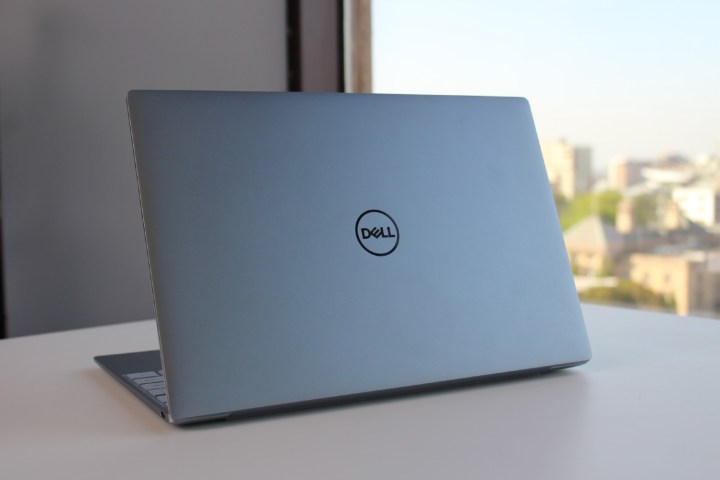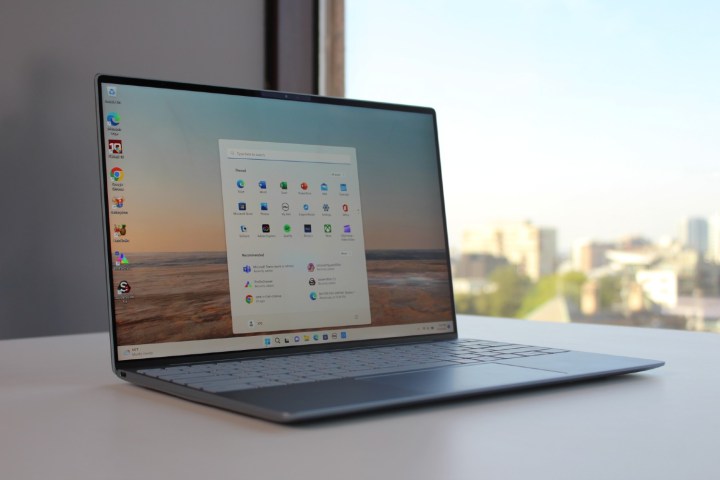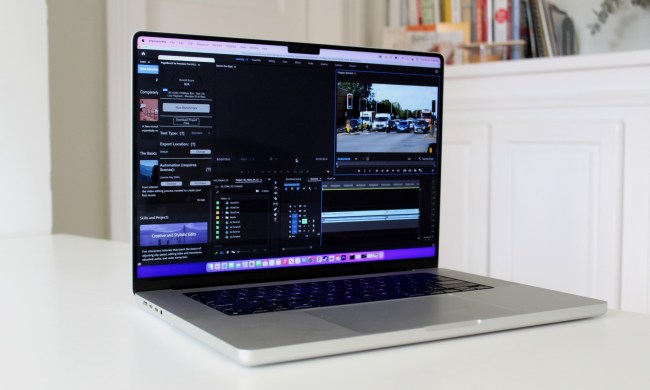
- Aggressive price
- Very compact design
- Great battery life
- Comfortable keyboard
- Display is bright and high quality
- No headphone jack
- Performance is lacking
The beloved Dell XPS 13 of previous years no longer exists.
The popular line of premium laptops is now split between the XPS 13 Plus and the standard XPS 13 – and that’s meant a new approach to distinguishing the two.
With the XPS 13 Plus as the more expensive, cutting edge, that leaves the standard XPS 13 as the cheaper offering. The result is a nerfed XPS 13 in terms of performance, but at an extremely affordable starting price of just $829.
Video review
Dell XPS 13 specs
| Dell XPS 13 (9315) | |
| Dimensions | 11.63 x 7.85 x 0.55 inches |
| Weight | 2.59 pounds |
| Processor | Intel Core i5-1230U
Intel Core i7-1250U |
| Graphics | Intel Xe Graphics |
| RAM | Up to 32GB LPDDR5 5200MHz |
| Display | 13.4-inch 1920 x 1200 IPS |
| Storage | Up to 1TB PCIe SSD |
| Touch | Optional |
| Ports | 2x Thunderbolt 4 ports |
| Wireless | Wi-Fi 6E and Bluetooth 5.2 |
| Webcam | 720p + IR camera |
| Operating system | Windows 11 |
| Battery | 45 watt-hour |
| Price | Starts at $829 |
A familiar design

Taking a look at the design, there are a few notable changes from previous generations of the XPS 13. Like the Plus model, this one is all aluminum, so no more carbon-fiber weave in the palm rests. I’ll definitely miss the white color option and the unique materials of the old XPS laptops.
Dell now offers the lighter “Sky” color, which is the one I have, and the darker “Umber” model. The Sky color is interesting too, since the keycaps are a slightly different color. It all comes together in a color scheme that feels unique. These aren’t standard silver and black, at least.
Dell hasn’t bought into the trend toward sharper 1080p webcams.
The super thin bezels are still here, of course. As the pioneer of super-thin laptop bezels, Dell’s design remains the most aggressive with its screen-to-body ratio. It looks as spectacular as ever.
Unfortunately, the persistence to keep the look, means it’s still stuck on a tiny 720p webcam housed in the top bezels. It’ll get by for the occasional Zoom call, but it’s not the most flattering in terms of image quality. It does some odd things with colors, and struggles in common video conferencing scenarios, especially if the lighting isn’t perfect. Dell hasn’t bought into the trend toward sharper 1080p webcams, especially not at the expense of its hard-earned top bezel.

The display itself hasn’t changed this time around either. It’s still a 16:10 IPS panel with options for touch or non-touch. You can crank it up to 444 nits, which is plenty bright, even if you’re working outside or near a window. Of course, color saturation (AdobeRGB 75%) isn’t wide as the high-resolution OLED models available on the XPS 13 Plus. But for the purposes of a sub-$1,000 laptop, this is an excellent display.
Dell has also saved many of more experimental design features for the XPS 13 Plus. So, no haptic feedback trackpad, edge-to-edge keyboard, or capacitive touch buttons that replaced the function row. Everything here is more familiar and more comfortable.
I miss the haptic trackpad from the XPS 13 Plus.
The one aspect I actually miss from the Plus model is the haptic trackpad. I loved the implementation of it, and the chunkier click of the standard XPS 13’s touchpad feels tiresome in comparison. Double clicks aren’t as smooth, and the click mechanism is overly loud.
While the XPS 13 Plus got a lot of the flashier new features, it retained a very similar internal design to previous generations of the XPS 13. The standard XPS 13, though, couldn’t be more different on the inside.
Redesigned internals

A lot of engineering work has gone into making the Dell XPS 13 thinner. It’s now 0.55 inches thick, which makes it one of the thinnest Windows laptops you can buy. And it does feel really thin to hold, despite the fact that it’s actually only 5% thinner than the previous model. But as I’m sure you know, at this size, every millimeter shaved off comes with a mountain of work behind the scenes.
First off, Dell says the motherboard is 1.8 times smaller overall this time around, including using a thinner PCB, which is actually now using a tech borrowed from smartphone boards. Pulling off the back cover, you can see how little space the motherboard now takes up — it’s pretty astounding. Dell has found ways to shrink basically every component, including the storage and memory — and without getting into all the details, it’s an impressive amount of engineering work that went into this internal redesign. But the result, again, is just a 5% reduction in thickness.

And if it sounds like I’m not impressed, it’s because there’s this little laptop out there called the M2 MacBook Air. At 0.44 inches thick, the MacBook Air is still 20% thinner than the XPS 13. That sounds like more than it really is, though. You won’t see a huge difference in thickness when you set these laptops side by side, and Dell has put in a lot of work to make sure of it.
But when it comes down to it, the real kicker with the new XPS 13 is the performance. In attempts to shrink everything down, you get just one fan, and with it, just a 9-watt processor from Intel’s 12th-gen U-series chips. These chips have just two Performance cores, which is four fewer than the P-series chips like the one used in the Dell XPS 13 Plus.
| Geekbench (single / multi) |
Handbrake (seconds) |
Cinebench R23 (single / multi) |
PCMark 10 Complete |
|
| Dell XPS 13 (Core i5-1230U) | 1393 / 4,459 | 333 | 1379 / 3457 | 4023 |
| Lenovo ThinkPad X1 Nano Gen 2 (Core i7-1280P) |
1493 / 8668 | 126 | 1575 / 7595 | 5094 |
| Dell XPS 13 Plus (Core i7-1280P) |
1316 / 8207 | 127 | 1311 / 6308 | 4309 |
| Asus Zenbook S 13 OLED (Ryzen 7 6800U) |
1417 / 6854 | 112 | 1402 / 8682 | 5647 |
| HP Elite Dragonfly G3 (Core i7-1265U) | 1699 / 5936 | 194 | 1618 / 5601 | 4975 |
The main purpose of nerfing the XPS 13, I assume, is to distinguish the XPS 13 from the Plus model, which uses a more standard 15-watt processor. Less power means less performance – and in this case, it’s actually quite a bit less. This is one of the worst-performing Intel 12th-gen laptops I’ve tested so far. It’s even a bit slower than last year’s 11th-gen model. But with a 9-watt processor that has only two Performance cores, it’s kind of what I’d expected.
That might sound horrible, but really, I would argue that last year’s performance is probably enough. You shouldn’t be buying this laptop to edit video all day or play games. Instead, it’s for web browsing, online work, video conferencing, the occasional photo edit or coding project — and this laptop handles all of that just fine.
It’s the multi-core performance that suffers the most, after all, and for the most part, those types of applications are just not what a laptop of this type is for. Furthermore, when it comes to choosing the processor for a laptop, it’s not all about performance. Looking beyond the benchmarks, you’ll see a number of advantages that better suit the Dell XPS 13 to compare with a laptop like the M1 MacBook Air.
The hidden benefits of less power

First off, the XPS 13 handles heat much better than the XPS 13 Plus. One of my biggest complaints with that laptop was how hot the surface temperatures got, even when running pretty standard applications. The XPS 13 doesn’t have that problem, and actually does a fantastic job at staying both cool and quiet. There’s only that one fan, and it never gets overly loud.
Of course, you’ll find an “Ultra Performance” thermal mode in the My Dell utility, which can crank the fan a bit more. Unlike some Performance modes found in other laptops, this one does quite a bit. Toggling on Ultra Performance mode while encoding a video in Handbrake, for example, netting me a 42% faster completion of the task. This put it closer to other 12th-gen U-series laptops, showing just how far the default “Optimized” mode is weighed toward a quiet, cool experience.
Battery life is the second benefit of Dell using a lower-powered chip on the XPS 13. This thing lasted well over 13 hours in light web browsing, which is over 5 hours longer than the XPS 13 Plus. As long as I didn’t have too many long video calls, I found that I could through the majority of a day away from an outlet. You’ll still get a solid four or five more hours out of the M2 MacBook Air, but in terms of Windows laptops, the Dell XPS 13 is back at the front of the pack.

The question remains: would you trade a few extra hours of battery life for a step down in multi-core performance? I think for most people looking at buying this laptop, the battery life is more useful.
And lastly, there’s the price. Opting for this lower-powered chip has allowed Dell to price the XPS 13 very aggressively. The starting configuration, which is the one I’m reviewing, costs just $829. That base-level configuration even comes with 512GB of storage, meaning it’s at least $400 cheaper than the M1 MacBook Air when similarly configured.
And Dell isn’t really even offering higher-end configurations — at least not right now. No high-resolution OLED screens or 2TB storage options are available at the moment, leaving those for the XPS 13 Plus. Even so, there’s just not another laptop at this price point that can compete in terms of overall value.
When missing a headphone jack is a problem

But there’s one decision Dell made with the XPS 13 that feels like undoes all the clever engineering and marketing behind this laptop. It doesn’t have a headphone jack. Just like the XPS 13 Plus, the XPS 13 has said goodbye to the beloved 3.5mm headphone jack, offering you just two Thunderbolt 4 ports in exchange.
An adapter is included in the box, thankfully, but that doesn’t take away the sting of feeling a bit duped.
The lack of a headphone jack is a compromise most people won’t see the need for.
Dropping the headphone jack on the XPS 13 Plus made some sense. It was meant to be a cutting-edge laptop, after all, that pushed the boundaries of design. People knew what they were getting into. And with the edge-to-edge keyboard and touch buttons, it felt like you were trading the unique design for a sleeker design.
But with the XPS 13, Dell may have taken it a step too far — and that’s coming from someone who isn’t fully against the idea of laptops without headphone jacks. I don’t think people use their headphone jacks as much as they think they do. But on a laptop like the XPS 13, especially at its lower price, it’s a compromise most people won’t see the need for. And I’m not sure I do either.
Buy it, but tread lightly

In a lot of ways, the new XPS 13 feels like a response to the overwhelming success of the M1 MacBook Air. While the rest of the Windows ecosystem has continued on, almost pretending as if the MacBook Air didn’t exist, the XPS 13 feels like it’s actually been designed around beating Apple at its own game.
It’s still not as powerful or long-lasting as the MacBook Air, but at $829, it’s a killer deal. I love that Dell wasn’t afraid of using the price as an attack against Apple, even if it meant making a few compromises along the way. If I could find a way to add back in a headphone jack, I’d have few qualms recommending this laptop to most people shopping for a Windows laptop. But even as it is, you won’t find another premium laptop under $1,000 quite this good.



